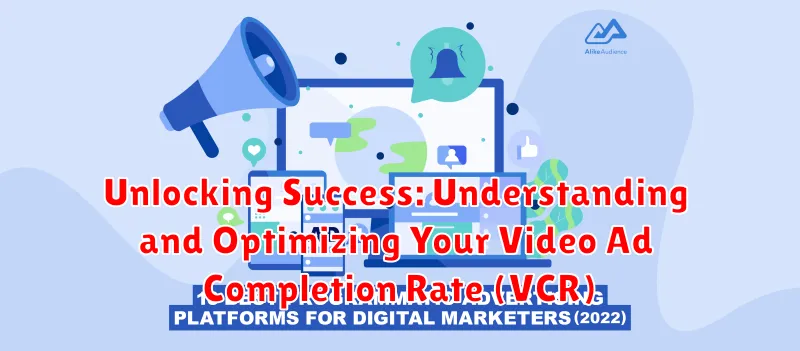In today’s dynamic digital landscape, video advertising has emerged as a powerful tool for brands to connect with their target audiences and drive meaningful engagement. However, simply launching a video ad campaign is not enough. To truly maximize your return on investment, you need to understand and optimize your Video Completion Rate (VCR). The VCR, a crucial metric in digital marketing, represents the percentage of viewers who watch your video ad from start to finish. A higher VCR indicates that your content is compelling, relevant, and effectively holding viewers’ attention, ultimately leading to improved brand awareness, recall, and conversions.
This article will serve as a comprehensive guide to unlocking success in your video advertising efforts by focusing on the significance of VCR. We will delve into the factors that influence video ad completion rates, exploring the best practices for creating engaging and captivating video content. Furthermore, we will outline practical strategies for optimizing your video ad campaigns to boost your VCR and achieve your desired marketing objectives. By mastering the art of understanding and improving your video completion rate, you can significantly enhance the effectiveness of your video advertising and drive tangible results for your business in the competitive global market.
What is Video Ad Completion Rate (VCR)?
The Video Ad Completion Rate (VCR) is a crucial metric in digital advertising that measures the percentage of viewers who watch a video advertisement from start to finish. In essence, it quantifies how effectively your video ad captures and maintains audience attention.
A higher VCR indicates that your ad is engaging, relevant, and successfully holding the viewer’s interest. Conversely, a low VCR suggests that the ad may be failing to resonate with the target audience, potentially due to factors such as poor content, irrelevant targeting, or a disruptive user experience.
VCR is typically expressed as a percentage, calculated by dividing the number of completed video views by the total number of video ad impressions served. Monitoring and optimizing VCR is essential for maximizing the ROI of video advertising campaigns.
Why is VCR Important for Video Advertising Campaigns?
The Video Ad Completion Rate (VCR) is a crucial metric for evaluating the success and effectiveness of video advertising campaigns. A high VCR signifies that viewers are engaged with your content and are watching it through to the end. This directly impacts brand awareness and recall, as complete views increase the likelihood of your message resonating with the audience.
Furthermore, a strong VCR often translates to improved Return on Ad Spend (ROAS). When viewers complete the ad, it indicates a higher level of interest and potential for conversion. Platforms like YouTube reward ads with higher completion rates by offering lower costs per view and increased reach. Thus, optimizing for VCR is not just about engagement, but also about maximizing the efficiency of your advertising budget.
In summary, VCR is a critical indicator of ad relevance, audience engagement, and campaign efficiency, directly impacting brand recognition, potential conversions, and advertising costs.
Factors Influencing Video Ad Completion Rate
Several elements impact the Video Ad Completion Rate (VCR). Understanding these factors is critical for optimizing ad performance.
Ad Relevance and Targeting: Ads that resonate with the viewer’s interests and demographics are more likely to be watched in their entirety. Mismatched or irrelevant ads lead to early abandonment.
Ad Length: Shorter, more concise ads generally have higher completion rates. Viewers are less likely to commit to longer ads, especially if the initial content doesn’t immediately capture their attention.
Ad Placement: Where the ad appears within the user experience significantly affects VCR. Intrusive or poorly placed ads may be skipped or abandoned quickly.
Creative Quality: Compelling visuals, engaging storytelling, and high production value contribute to a higher VCR. A poorly produced or uninteresting ad will struggle to hold viewer attention.
Call to Action (CTA): A clear and compelling call to action encourages viewers to engage with the ad beyond simply watching it. A weak or missing CTA can lead to passive viewing and lower overall engagement metrics.
How to Calculate Video Ad Completion Rate?
The Video Ad Completion Rate (VCR) is a straightforward calculation, representing the percentage of viewers who watch a video ad from start to finish. Understanding how to calculate this metric is crucial for assessing the effectiveness of your video advertising campaigns.
The formula for calculating VCR is as follows:
VCR = (Number of Completed Video Views / Total Number of Video Views) * 100
Where:
- Number of Completed Video Views: The total number of times your video ad was watched to its entirety.
- Total Number of Video Views: The total number of times your video ad was initiated, regardless of whether it was completed.
For example, if your video ad was started 1000 times and fully viewed 300 times, your VCR would be (300 / 1000) * 100 = 30%.
This percentage provides a clear indication of how engaging your video content is to the target audience.
Strategies to Improve Your Video Ad Completion Rate

Optimizing your video ad completion rate (VCR) requires a multifaceted approach focused on capturing and retaining audience attention. Several strategies can be implemented to enhance viewer engagement and encourage complete viewing.
Optimize Ad Length: Shorter ads generally yield higher completion rates. Condense your message to its most essential points, aiming for concise and impactful content.
Compelling Opening: The first few seconds are crucial. Start with a visually engaging hook, a question, or a surprising statement to immediately grab viewers’ interest.
Clear Value Proposition: Communicate the benefit of watching the ad. What will the viewer gain by watching the entire video? Make this clear early on.
Visual Storytelling: Use high-quality visuals and dynamic storytelling techniques to keep viewers entertained and invested in the narrative.
A/B Testing: Experiment with different ad elements, such as headlines, visuals, and calls to action, to identify what resonates best with your target audience.
Audience Targeting: Ensure your ads are reaching the right audience. Precise targeting increases the likelihood of engagement and completion.
Call to Action (CTA): Include a clear and concise CTA at the end of the video, guiding viewers on the next step they should take.
VCR Benchmarks: What is Considered a Good Completion Rate?
Determining a “good” Video Ad Completion Rate (VCR) requires understanding that benchmarks vary across industries, ad formats, and target audiences. While a universally applicable number is elusive, aiming for a VCR above 70% is generally considered strong performance.
Several factors influence this benchmark. Shorter, non-skippable ads typically achieve higher completion rates. Furthermore, ads placed within highly engaged content or targeted to receptive audiences tend to perform better.
Industry-specific benchmarks also exist. For instance, ads targeting the gaming community might see higher average VCRs compared to those targeting financial services. Therefore, comparing your VCR against industry averages provides a more contextualized understanding of your ad’s performance.
Ultimately, track your VCR regularly and focus on continuous improvement. Use your own historical data as a baseline and strive to exceed it through optimization efforts. A consistently improving VCR signals effective ad content and targeting strategies.
The Relationship Between VCR and Other Key Metrics
Video Ad Completion Rate (VCR) doesn’t exist in isolation. It significantly impacts and is influenced by other vital advertising metrics. Understanding these relationships is crucial for a holistic view of campaign performance.
Click-Through Rate (CTR): A high VCR can indirectly influence CTR. Compelling videos that are fully watched are more likely to leave a positive impression, potentially leading to increased clicks on associated calls-to-action or website links.
Conversion Rate: Completing a video ad can directly correlate with higher conversion rates. If the video effectively communicates the value proposition and generates interest, viewers are more inclined to take the desired action (e.g., purchase, sign-up). A low VCR may indicate that the video is not compelling enough to drive conversions.
Cost Per Acquisition (CPA): By optimizing VCR, advertisers can potentially lower their CPA. A higher VCR means more viewers are seeing the full message, increasing the likelihood of conversions and improving the efficiency of ad spend. A well-optimized VCR contribute to a reduced CPA.
Brand Awareness: A high VCR indicates that a significant portion of the target audience is engaging with the brand’s message, contributing to increased brand awareness and recall.
Tools for Tracking and Analyzing Video Ad Completion Rate
To effectively optimize your video ad completion rate, employing the right tools for tracking and analysis is crucial. These tools provide invaluable insights into viewer behavior, allowing you to identify areas for improvement and refine your strategies.
Key Tools for VCR Tracking:
- Platform Analytics: Most video advertising platforms (e.g., Google Ads, YouTube Ads, Facebook Ads) offer built-in analytics dashboards that track VCR and other key metrics. These are essential for getting a high-level overview of your campaign performance.
- Third-Party Analytics Providers: Services like Nielsen, Comscore, and Moat offer more granular and independent measurement of video ad performance across various platforms. They often provide advanced features like viewability analysis and audience insights.
- Custom Tracking Solutions: For specific needs, you can implement custom tracking using Javascript and analytics platforms like Google Analytics. This allows you to track specific events and user interactions within your video ad.
These tools empower marketers to understand how viewers are engaging with their video ads, identify patterns, and make data-driven decisions to improve VCR and overall campaign effectiveness.
Best Practices for Optimizing Video Ad Content for Higher VCR
Optimizing your video ad content is crucial for achieving a higher Video Ad Completion Rate (VCR). By implementing these best practices, you can significantly improve viewer engagement and ensure your message is received.
Key strategies include:
- Captivating Introductions: Grab attention within the first few seconds. Use compelling visuals, intriguing questions, or shocking statements.
- Concise Messaging: Keep your message clear, focused, and to the point. Avoid unnecessary jargon or complex narratives.
- Visually Appealing Content: High-quality visuals are essential. Use professional-grade footage, animations, and graphics.
- Mobile Optimization: Ensure your video is optimized for mobile viewing, as a significant portion of viewers will be watching on smartphones.
- Compelling Call to Action: Include a clear and concise call to action at the end of the video, guiding viewers on what to do next.
- Audience Relevance: Tailor your content to resonate with your target demographic’s interests and needs.
By prioritizing these elements, you can create video ads that are more engaging, memorable, and ultimately, achieve a higher completion rate.
Case Studies: Successful VCR Optimization

Analyzing case studies provides tangible examples of how strategic adjustments can significantly impact VCR. The following outlines instances where companies achieved notable improvements:
Case Study 1: E-commerce Brand – Product Demo Ad
An e-commerce brand selling kitchen appliances initially had a VCR of 25% on their product demo ads. By shortening the ad from 60 seconds to 30 seconds, focusing on the core features within the first 10 seconds, and incorporating a stronger call to action, they increased their VCR to 45%. Key takeaway: brevity and immediate value proposition are crucial.
Case Study 2: Mobile Gaming Company – App Install Ad
A mobile gaming company faced low VCR (18%) due to a slow introduction of gameplay. By front-loading the most exciting gameplay footage and adding engaging visuals throughout, their VCR jumped to 38%. Furthermore, A/B testing different calls to action led to an additional 5% increase. Key takeaway: Captivate viewers early and continuously.
Case Study 3: SaaS Company – Explainer Video
A SaaS company’s explainer video struggled with a VCR of 20%. By segmenting their audience and tailoring the video content to address specific pain points for each segment, they witnessed an average VCR increase of 15%. Key takeaway: personalization significantly boosts engagement.

